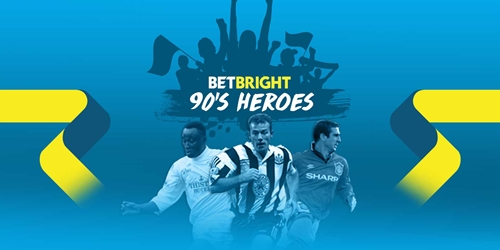’90s Heroes is a series by Adam Hurrey on the Bet Bright football blog which looks back on the legends of the game in what now seems a simpler time for football.
Duncan Ferguson; Jurgen Klinsmann; Faustino Asprilla; Juninho; Tony Yeboah; Georgi Kinkladze; David Ginola; Chris Waddle; Gianfranco Zola; Niall Quinn and Kevin Phillips; Dion Dublin; Robbie Fowler; Stuart Pearce; Mark Hughes; Paul Gascoigne.
The soundtracks to YouTube goal compilations are hardly the last bastion of good taste – all dirty house drops and tired Requiem for a Dream imitations – but if anyone deserves to have their scoring output set to Mozart’s Divertimento in D major, it’s the greatest footballer ever to come out of Guernsey.
There’s 286 seconds of pure Matthew Le Tissier to set the mood.
Guernsey Boy
By the summer of 1990, Le Tissier – by now a fixture in the England under-21 side – was the PFA Young Player of the Year and outscoring the likes of Ian Rush and Mark Hughes with 20 goals in the top flight – and doing so with the dictionary definition of aplomb:
That impact may have come too early to sneak a place in the national squad for Italia ‘90, but Tottenham (Le Tissier’s boyhood club) were sufficiently impressed to try and lure him to White Hart Lane to form what in retrospect would have been a fascinating strike partnership with Gary Lineker. “It was pretty much a done deal,” Le Tissier told FourFourTwo in 2010. “I’d agreed terms on the contract and everything. But I pulled out of it because I was about to get married and my fiancée at the time didn’t fancy living in London.”
Still just 21, and with almost a half-century of senior goals to his eye-catching name, there would surely be plenty of opportunities to fly the Southampton nest and then spread his wings at international level.
The Second Coming
It took until his mid-20s for Southampton’s No.7 to negotiate his way to another level. The 1993/94 bears all the hallmarks of being Peak Le Tissier: a haul of 25 immaculate Premier League goals helped Southampton survive relegation by a point, only for it to be eclipsed by the comparatively vulgar plundering of out-and-out strikers Andy Cole (34 goals) and Alan Shearer (31), which would command a total of £22m in transfer fees within the next couple of years.
Just edged out for the BBC’s Goal of the Season by Rod Wallace – Le Tissier was now becoming accustomed to playing second fiddle beyond the confines of The Dell – was his masterpiece against Newcastle.
Having left such vivid mid-1990s iconography as Barry Venison’s mullet and adverts for Street Fighter II trailing behind him, he lobbed the ball over the head of the final defender Kevin Scott. Showing more restraint than any 25-year-old man ought to possess, Le Tissier somehow resisted the pure footballing urge to unleash a 14-yard volley past a helpless Mike Hooper, rummaged around in his bag of tricks, and opted for Nonchalant Sidefoot.
Le Tissier often recalls that finish with a curious brand of jovial humility that doesn’t quite fully convince. “Yeah, that Newcastle one I mis-hit in the end. It bobbled into the corner, which wasn’t how it was supposed to go in, so that took the gloss off it a bit for me.”
After Andy Cole briefly threatened to upstage him with an equaliser at the other end, Le Tissier ultimately succeeded in upstaging himself. His second goal – an absurd piece of purely instinctive magic, almost in one single movement, in the 87th minute – feels like a mere footnote in comparison with the first. Thigh, boot, goal, f**k off.
Should anyone – incoming England manager Terry Venables included – have been in any doubt about Le Tissier’s glorious Premier League maturation, there was more magic to come. Another audacious swing of the boot against Wimbledon…
…was followed by the bewitching, blood-twisting dribble and Flowers-wilting curler against Blackburn that secured the following year’s Goal of the Season vote, while probably also scraping into the top 3 Le Tissier Goals He Couldn’t Really Celebrate Properly Because Southampton Were Still Losing At The Time:
Solo spectacles like that simply served to feed the impression that Southampton were a one-man survival act. Rather than swell the Le Tissier ego, however, he revealed to the Independent in 1996 the pressure of life as a sizeable fish in a modest pond.
“The one-man team stuff went way over the top, and I got a lot of stick from the lads which placed unwanted pressure on me. Not so much on the pitch, but in the dressing-room. I would spend most of midweek playing myself down as a result, because you live or die by how you conduct yourself in the dressing-room.”
The Dip and the Chip
Another attempt to prise Le Tissier away from his permanent south-coast stepping stone was stonewalled by Southampton in the summer of 1995, and Chelsea eventually spent their money on Mark Hughes, Gianluca Vialli and Gianfranco Zola instead.
Had Le Tissier been tempted away halfway through the 1990s, he would have left Southampton fans with more than enough in the memory banks but – despite starting the 1995/96 season with a hat-trick of set pieces against Nottingham Forest, and still ending up on the losing side – Southampton’s talisman was about to experience the first serious dip in form of his career.
“A dip in form was bound to happen because at one point it seemed as if everything I hit from outside the area was finding the top corner,” Le Tissier told the Independent.
“Suddenly the shots started to hit the post or miss by a few inches, the club got off to a bad start, and my season quickly turned into a nightmare. I ended up getting sent off at The Dell against Liverpool for two bookable offences.
I think that was the lowest point of my career. I ran straight into the dressing-room and sat there thinking that everything was working against me, we were losing again, I was not playing well, and I couldn’t even get the England squad. I felt extremely low, I can tell you.”
Three relegation-defying goals in the final six games of the season, plus a pep talk from his idol and new England coach Glenn Hoddle, dragged Le Tissier out of his malaise.
There was also another new face at The Dell – Graeme Souness became the fifth of nine managers to have Le Tissier’s class to thank for keeping them hovering above the dotted line of the league table – and, despite furious competition from Ali Dia, Le Tissier top-scored again for the Saints.
An autumnal run of seven goals in six games was crowned in astonishing 6-3 win over Manchester United, at a time when chipping a stranded Peter Schmeichel was threatening to become the Mannequin Challenge of its day:
That familiar Le Tissier dribble – performed barely above walking pace, but still untouchable – set up the “chance”, which he converted by reaching into his bag of clubs and selecting the sand wedge instead of his usual five iron. But while Le Tissier continued to master the greens of the Premier League, his international ambitions remained in the rough.
England’s square peg
On the fairly frequent occasions that Le Tissier is asked to reflect on his unique career, the time he spends defending his decision to remain at Southampton is matched only by that reserved for lamenting his lack of opportunities in an England shirt.
By the tail-end of Venables’ tenure, Le Tissier had become, in the words of the Independent’s Ian Ridley, “the Glenn Hoddle for the Nineties: not so much a player, more a national debate.”
Even allowing for the astonishing glut of English striking talent at the time – with a handful of proven goalscorers feeling similarly aggrieved at their modest cap collection – Le Tissier’s eight games in three years feels as ridiculous now as it was puzzling at the time. Highlights weren’t just few and far between; they were virtually non-existent.
His fourth cap, the visit of Gheorghe Hagi and the classy Romania to Wembley in October 1994, seemed like the ideal moment to make a mark. Le Tissier went into his first England start with 10 goals in 10 games for Southampton and Venables granted him a free role behind Shearer and Ian Wright.
It would be churlish not to admire Le Tissier’s body of work, but it’s just as much a part of football to speculate on what could have been. International careers – often starved of momentum – can hinge on mere moments, and the ninth minute could so easily have been Le Tissier’s:
After that came a short string of anti-climaxes. Le Tissier’s second start against Ireland lasted just 27 minutes before crowd trouble forced the game in Dublin to be abandoned.
His final chance came in a World Cup qualifier against Italy at Wembley, before which his brother Karl had unwittingly revealed Hoddle’s surprise gameplan on BBC radio: that Le Tissier would roam freely behind Shearer along with Steve McManaman. Cometh the hour, cometh the disappointment – England 0 Italy 1, Le Tissier off, Les Ferdinand on.
That would be that for Le Tissier under Glenn Hoddle’s England watch, save for the mild indignity of an England B audition at Loftus Road against Russia’ second string. Taking the field alongside such 1998 World Cup squad unhopefuls as Carl Serrant, Darren Williams and Wayne Quinn – and in front of one fan’s quaint homemade banner of:
“PLEASE, HOD….PICK LE GOD!” – Le Tissier belted the saddest hat-trick of all time past the second-best goalkeeper in the Kharine family:
Vague hopes that Le Tissier could have been at France ‘98 in a blue shirt were also dashed: Le Tissier was eligible for Scotland, but is said to have turned them down before his England call-up. He later confirmed to FourFourTwo that the tantalising proposition of lining up for France alongside Zinedine Zidane, meanwhile, was never an option.
“Firstly, the France thing was a load of rubbish. The French FA thought I might be able to play for them and Houllier was ringing my dad to ask him to try and persuade me, but I didn’t have any French relatives so it was a non-starter.”
All things considered, then, Le Tissier’s biggest contribution in an England shirt was a forgotten novelty: opening the scoring in Peter Shilton’s testimonial at White Hart Lane against an Italia ‘90 all-star team boasting Carlos Valderrama, Michel Platini and…Gudni Bergsson.
“[Andy] Gray said he shouldn’t look at that lazy so-and-so, and even when Ron [Atkinson] showed him my scoring record in the Rothman’s Football Yearbook, Gray refused to budge and said I didn’t work hard enough. So that was that. And that is how it often works in football.” – Le Tissier recalls another Southampton exit that didn’t materialise.
The biggest shame (alright, it’s in the top 3) of Le Tissier’s 16 years of loyalty to Southampton was that the majority of his other-worldly goals were scored into the crappest goalnets top-flight football has ever witnessed. There would be a well-deserved romantic twist, though, as the last competitive goal ever to ping back out of The Dell’s pathetic netting came via the boot of its greatest artist-in-residence.
After 89 minutes of Southampton’s last Premier League match before leaving for St Mary’s, Le Tissier produced another perfectly-timed masterpiece and Premier League goal no.101:
The Dell became a housing estate, complete with Le Tissier court and – what we must dearly hope is not a coincidence – a rather different tribute. Tucked away where the car park used to be is a tiny cul-de-sac called Crossley Place, which happens to share its name with the only goalkeeper ever to save a Matt Le Tissier penalty:
Anyway, with his Southampton goalscoring account tidily closed, injuries finally forced Le Tissier to retire in 2002. “Le God” went quietly and reluctantly took his nickname with him:
“I get really embarrassed about it. Apart from anything else, it places me in awkward position, and more than once I’ve been contacted by religious people asking me to make a statement making it plain that I should not be seen in such a light. It’s all got ridiculous, really.”
Le Tissier has truly nailed the art of ex-pro self-deprecation, which tidily offsets the fondness of the plaudits that continue to come his way. For every anecdote from the likes of Xavi (“The man I absolutely loved watching as a kid was Matt Le Tissier, he was sensational. He was definitely an idol”) there is a chuckling reminder from the man himself of his professional flaws:
Watching the lads train at staple wood this morning, bringing back happy memories of the rare days I enjoyed training ?
— Matt Le Tissier (@mattletiss7) March 10, 2016
England’s loss was Southampton’s eternal gain, but Matt Le Tissier’s Mozart-worthy montage suggests he should be remembered for rather more than the what-could-have-beens.
For the next instalment of ’90s Heroes check out the Bet Bright football blog this week.







